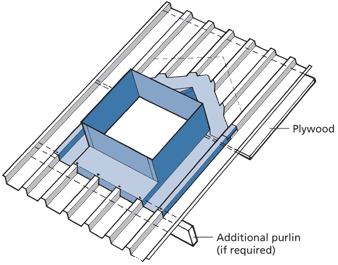Details
The details and techniques can be used in most circumstances and can be combined in various ways. There are many types of acceptable penetration flashing designs, but some are only suitable where the roof pitch is greater than the minimum recommended pitch for that particular profile.
Some are acceptable practice only, and the preferred method is recommended.
All penetration flashing details should be planned; on-site improvised solutions are not acceptable. Where the skill of the roofing contractor does not extend to sheet metal work, other people possessing those skills should be used for the design and manufacture penetration flashings.
All penetrations over 300 mm wide require the additional structural support of either extra purlins or plywood with a minimum thickness of 12 mm. H3 treated plywood should be securely fastened to the structure and provide not only support for the flashings and sheeting, but is also required for additional fixing.
- Log in to post comments

